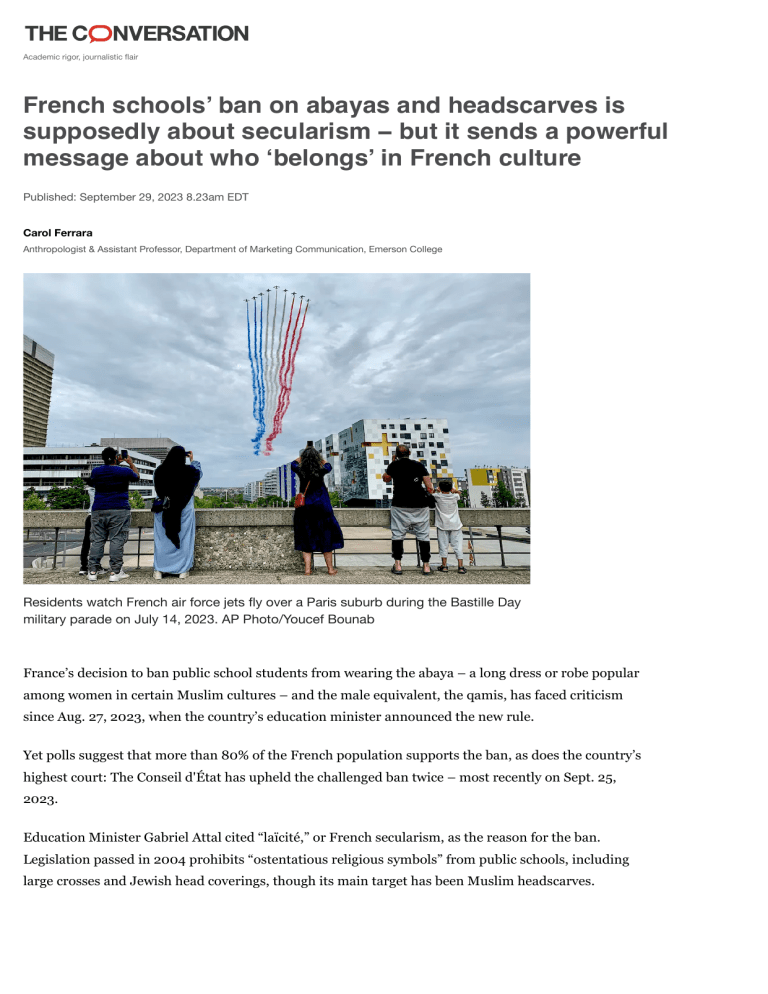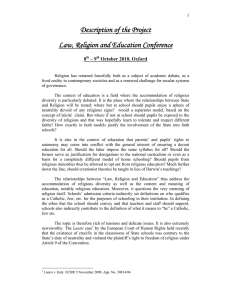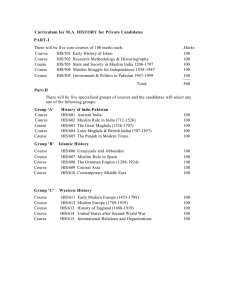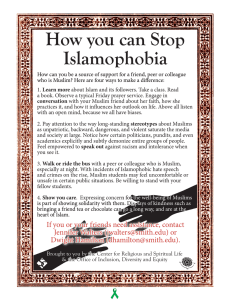
Academic rigor, journalistic flair French schools’ ban on abayas and headscarves is supposedly about secularism − but it sends a powerful message about who ‘belongs’ in French culture Published: September 29, 2023 8.23am EDT Carol Ferrara Anthropologist & Assistant Professor, Department of Marketing Communication, Emerson College Residents watch French air force jets fly over a Paris suburb during the Bastille Day military parade on July 14, 2023. AP Photo/Youcef Bounab France’s decision to ban public school students from wearing the abaya – a long dress or robe popular among women in certain Muslim cultures – and the male equivalent, the qamis, has faced criticism since Aug. 27, 2023, when the country’s education minister announced the new rule. Yet polls suggest that more than 80% of the French population supports the ban, as does the country’s highest court: The Conseil d'État has upheld the challenged ban twice – most recently on Sept. 25, 2023. Education Minister Gabriel Attal cited “laïcité,” or French secularism, as the reason for the ban. Legislation passed in 2004 prohibits “ostentatious religious symbols” from public schools, including large crosses and Jewish head coverings, though its main target has been Muslim headscarves. Debate over the abaya, however, gets to the heart of debates over laïcité. Many critics argue that the abaya is a cultural garment, not a religious one, and should be allowed under laïcité. In practice, though, anything associated with Muslim cultures tends to be considered “religious.” Catholic traditions, meanwhile, are often considered “cultural” – and therefore compatible with laïcité. My ethnographic research in French schools, where secularism debates are particularly heated, suggests that the abaya ban and the earlier “headscarf law” aren’t really about defending laïcité. Rather, they protect a particular version of French identity – an identity infused with Catholic culture. Staff from a school on the outskirts of Paris protest against the government’s abaya ban on Sept. 6, 2023. Mohamad Salaheldin Abdelg Alsayed/Anadolu Agency via Getty Images ‘Catho-laïcité’ Despite its reputation as a staunchly secular country, France has a deep and tangled relationship with Catholicism. Recent studies show that only about 1 in 3 French people ages 18-59 consider themselves Catholic – whether in a religious or cultural sense – and weekly Mass attendance is uncommon. Yet the faith still has a powerful influence upon French culture. Attending church for holidays, funerals, weddings and baptisms remains commonplace. Crosses, church bells and public church processions are considered ordinary aspects of French culture, despite the official emphasis on laïcité as a unifying pillar of national identity. “I am convinced that the Catholic sap (of France) must still, and forever, contribute to the life of our nation,” President Emmanuel Macron said in a 2018 speech to bishops. By contrast, headscarves, abayas, minarets, the call to prayer, halal food and Islamic prayer in public spaces are often perceived as threats to French identity. Moreover, these get flagged as religious symbols, putting them in conflict with laïcité in ways that Catholic symbols avoid. Catholicism’s intimate relationship with secularism in France is sometimes referred to as “catholaïcité,” referring to how Catholicism, laïcité and Frenchness become almost interchangeable. Rather than neutral secularism, “laïcité” can represent a particular, Catholic-infused French identity that views religious or cultural “others” with suspicion. Santa Claus in class These contradictions are especially evident around Catholic holidays. In the lead-up to Christmas, schools often celebrate with decorations, concerts and even visits from Santa Claus – activities defended as cultural rather than religious. My 3-year-old son’s holiday concert in a public preschool just outside Paris included “O Christmas Tree,” “Little Father Christmas” and “Silent Night,” but no songs from other religious traditions despite many of his classmates’ Muslim heritage. People dressed as Santa Claus attend a paddleboarding parade on the Ill river in Strasbourg, France, on Dec. 3, 2022. Sebastien Bozon/AFP via Getty Images Controversies stemming from holiday activities point back to this idea of “catho-laïcité”: Traditions rooted in Christian culture are more likely to be considered cultural and thus compatible with both secularism and “Frenchness.” In 2018, an elementary school director in southern France canceled all Christmas-related activities to adhere to the “rules of laïcité” after a parent expressed disapproval. Community backlash was so fervent that the national ministry of education stepped in to intervene and reinstated the ostensibly cultural activities. More recently, a mayor in northern France issued an official authorization for Santa Claus to park on rooftops, publicly declaring that Santa would be “within the law” during his visit that season. Local public elementary school students were later surprised with a video of Santa Claus and his elves depositing gifts at their school. Fish, fowl and halal Discrepancies between how laïcité applies to different religious traditions do not emerge just at holidays. French school cafeterias often serve fish on Fridays, a Catholic tradition, but debates have raged over offering halal food or other substitutes. In 2015, a town in central France decided to stop providing substitutes for pork, which is forbidden in Muslim and Jewish tradition, in its school cafeterias. Officials argued that providing exceptions had impinged upon secular neutrality. In 2020, the case went to the top court, where judges declared that schools were not obligated under laïcité to provide alternative menu options for religious diets – though they added that doing so would not contradict laïcité. A placard at a 2019 protest in Toulouse reads, ‘France: it’s you and me.’ Alain Pitton/NurPhoto via Getty Images The following year, a middle school in Bordeaux began providing occasional halal meals, as well as nonhalal alternatives. Nonetheless, the move sparked significant protest from local parent groups that lamented the “flouting of the principle of laïcité.” Other options Families seeking alternative education options often turn to France’s state-funded private schools, which are allowed to offer optional religious education but must otherwise follow the national curriculum and accept students of any faith. Yet here, too, the playing field is uneven. There are more than 7,000 Catholic schools to choose from, and at some of them, upward of 70% of the student body is Muslim. Options for state-funded private Muslim schools, on the other hand – a focus of my research – are sparse. This is due, in part, to challenges that Muslim schools face when applying for permits and funding. Families can also choose from the approximately 100 independent Muslim schools, run without government funding. However, these face constant scrutiny compared with the roughly 200 independent Catholic schools – some of which do not support laïcité. People in front of a school in Trappes, France, protest the abaya ban on Sept. 8, 2023. Mohamad Salaheldin Abdelg Alsayed/Anadolu Agency via Getty Images Future consequences It is not clear how the abaya ban will affect students. On Sept. 4, 2023, only about 300 students out of France’s 12 million came to school wearing an abaya, and only 67 refused to remove it, according to the education ministry. The 2004 headscarf law, however, seems to have harmed Muslim girls’ educational success. According to one key study, the gap in secondary school completion rates between Muslim and nonMuslim women doubled among those who were teenagers when the ban was passed because of higher dropout rates. Moreover, the study’s authors argue that this disparity increased the employment gap between Muslim and non-Muslim women. Taking a closer look at France’s education system, I argue, shows that the abaya ban isn’t really about laïcité. If it were, Santa and Christmas songs would be relegated to the private sphere, and cafeteria menus would equally accommodate common religious diets. Instead, Catholic symbols are often embraced as integral to French culture, while Muslim symbols are scrutinized or barred – sending students a powerful message about what it means to be “French.”





